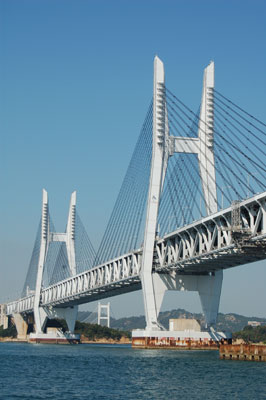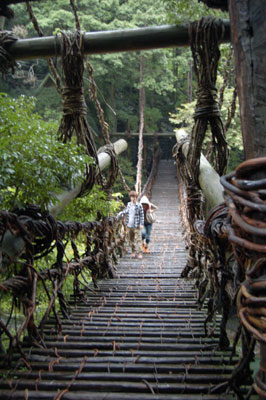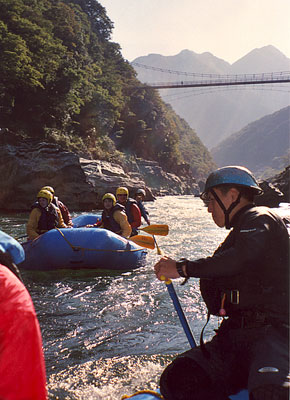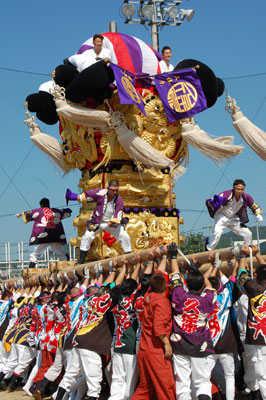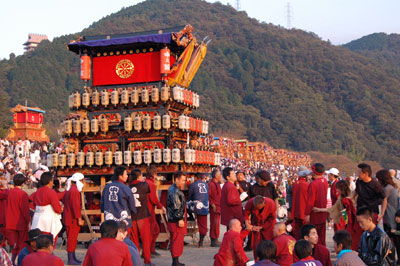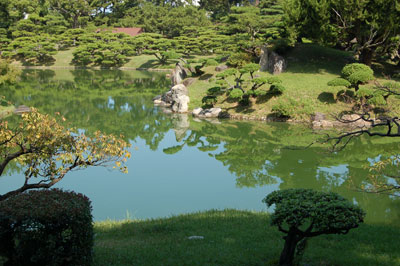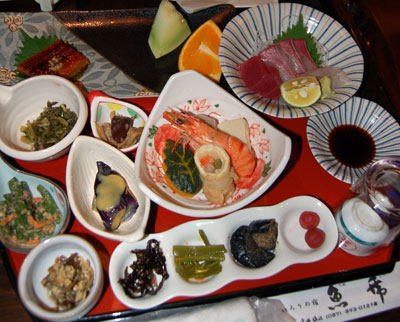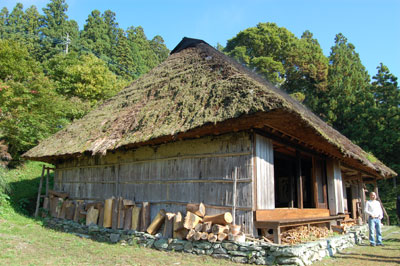Japan — Shining light on Shikoku
by David Tykol, Editor, ITN
While Shikoku is the smallest of Japan’s four main islands — tucked under the largest island, Honshu, and to the right of the southernmost, Kyushu — it promises big surprises, as I learned on a visit Oct. 13-18, 2008, as part of a small group of journalists.
Our gateway to Shikoku was the 8-mile Seto Ohashi Bridge series, which traverses five tiny islands in the Seto Inland Sea. Crossing this soaring structure aboard an express train traveling from Okayama, Honshu, to Takamatsu City provided a striking first impression!
Noodles in the mountains
Around the island’s northern cities and towns where we began our tour, the homes, businesses and factories we passed didn’t appear much different than what I was used to seeing in Northern California, except that most signs were in Japanese and in many open spaces there were rice fields. But the scenery soon would change. Shikoku is crossed by mountains and that’s where we headed next.
Around Miyoshi, the road narrowed to one lane as our bus pushed higher and higher into an ever-deepening gorge, a rocky river visible far below. The hillsides were dense with trees, including maple, oak, pine and, mostly, tall cedars, which, like the tall goldenrod that was blooming everywhere on the island, are not endemic.
Scattered on the steep slopes were houses and businesses each propped up on one side by stilts 30 to 50 feet tall. We stopped at one of these hillside-hugging homes near the community of Ochiai and spent some time learning the Iya method of making soba (buckwheat noodles) from scratch, grinding the wheat into flour on a small millstone, adding water and kneading it into a ball, then flattening that out and cutting it into slender strips ready for boiling. The soba became part of our lunch, eaten on the porch overlooking a stream a hundred feet below.
A 2-hour lesson at a soba juku, or soba dojo, costs ¥2,000-¥3,000 ($22.50-$34) per person, including a takeout meal.
Despite the language barrier, Ms. Reiko Tuzuki is a hostess whom visitors will love. She might even be persuaded to perform the song traditionally sung while making noodles. Mention her and her company, Okuiya Menme-juku (www.iya.jp/takumi/e.htm), when you make arrangements for a lesson through the City of Miyoshi Tourism Department (e-mail shoukoukankou@city.tokushima-miyoshi.lg.jp).
The vine bridge
Proceeding farther into mist-covered mountains lush with bamboo, tree-climbing vines and wildflowers, we came to Iya-no-Kazura Bashi (phone 0883 87 2275, www.miyoshinavi.jp), a kiwi-vine bridge that has been in place for three centuries.
Weighing five tons and measuring 147 feet long and six feet wide, this bridge, suspended by vines, looks like something out of a King Kong movie. It’s one of, originally, 10 bridges which, legend says, were built by a clan hiding from invaders.
In crossing the span, you step on slightly squared, slim tree trunks horizontally lashed together with vines the width of a finger. These planks are several inches apart, so you can see the rocks and the Iya River 45 feet below.
I found the walk across the bridge thrilling and wanted to stay longer. Another member of our group was not as enthused, however, and a half hour later said her heart was still pumping fast.
Located about 20 minutes by bus from JR Oboke Station in Miyoshi, the vine bridge is open year-round, sunrise to sunset (¥500).
A short walk up the shady road is the Biwa-no-taki (Biwa Waterfall), a slip of water running 150 feet down a hillside into a pool.
Another worthwhile stop is Nana-Magari (Seven Curves) in Iya Gorge, a viewpoint 600 feet above a river that sharply curves around the tapered end of a mountain ridge. For the best photos, take a wide-angle lens.
Oboke Valley rafting
Several of us spent a few hours one afternoon rafting the Yoshinogawa (gawa = river) in Oboke Valley, just west of Iya Valley. After seeing a video on what to expect and listening to all the instructions, we suited up in, essentially, wetsuits, donned helmets and jumped in the water before climbing into our rubber rafts.
The buildup had included so many increasingly dire warnings about what to do if we were thrown out of the raft or it tipped over that I was on edge for much of the run. When we finally were told we had passed through the roughest of the seven rapids, I realized there hadn’t been anything to worry about. That’s not to say it wouldn’t be rougher at a different time of year.
There were four of us plus a guide in each raft, and in between the exciting spots we admired the incredibly beautiful, blue rock formations all around us, watched for elusive monkeys and hawks in the trees or played rafting games the guides had devised.
This trip required some coordinated rowing and moving quickly from sitting to crouching, and our raft did fold up like a taco a time or two, a couple of us harmlessly banging helmets, but even with my crippled left arm and a game leg, I managed to be a help rather than a hindrance, and I would do it again.
It’s worth it to bring a waterproof camera. I had a small point-and-shoot, which snugly fit in a tupperware container provided by the guide, and I made good use of it whenever the guide gave the “all clear.”
I also learned not to spend too much time in the water, leisurely drifting, because warming back up was difficult, even in the sun.
Our 10-kilometer rafting adventure began at River Station West West with MontBell Outdoor Challenge (Shikoku office phone, +816 6538 0208, http://en.montbell.jp/event). Yoshino River rafting takes place July to September, due to the volume and temperature of the water, and costs ¥6,000-¥8,000 for a half day or ¥10,000-¥16,000 for a full day, including equipment, insurance, tax and guide. You’ll need to bring your own towel.
The next morning, everyone boarded a roofless Oboke Ravine Pleasure Boat (phone 0883 84 1211), removing our shoes before sitting on the tatami mats, and cruised slowly down and up a short stretch of the river, admiring the giant, marble-like, crystalline schist formations all around (¥1,050 adult).
The sites I’ve mentioned in both the Oboke and Iya valleys also can be seen on the 5½-hour guided tour “Nishi Iya Course” aboard the old-style, big-nosed Bonnet Bus of the company Awa Ikeda Kanko (1612-27, Sarada, Ikeda-cho, Miyoshi City; phone 0883 72 1231). Commentary is in Japanese, but brochures in English are available at hotels and other tourist sites. Departing daily March through November, a half-day tour costs ¥5,200, including lunch. A seat must be reserved three months in advance.
Ritsurin Park
One place that should not be missed on Shikoku is Ritsurin Park in Takamatsu, Kagawa Prefecture. In the 17th century, a garden covering 186 acres was landscaped there with 13 man-made hills, rock formations, six ponds (now full of koi), a thousand black pine trees and green plants of every sheen and striation.
Despite the park’s lack of almost any flowers, in some places on the South Pond walk I found myself reframing and shooting another picture every few steps. The lines of the paths, bridges and meticulously sculpted trees are graceful and elegant.
In the park, we ate lunch in the teahouse Hanka-tei, having left our shoes at the door as we did at many places on this trip. (For Japan, consider packing some slip-ons, without laces.) Sitting on tatami mats beside low tables, we had a view of the pond and park through unshuttered, open-air walls. The temperature was perfect, with a slight breeze. Be aware that summer can bring mosquitoes and it can get quite hot.
At Hanka-tei, a light breakfast of porridge, served from 7 to 10 a.m., costs ¥1,260. Lunch, served 8 a.m.-6 p.m., starts at ¥3,000, and dinner, served until 9, starts at ¥7,500 or, with five or more people, from ¥5,000 per person.
Steps away is Hanazono-tei, a shop and walk-in restaurant where lunch or dinner can be bought anytime for ¥800-¥5,000.
Reservations are required at Hanka-tei but not at Hanazono-tei. Both teahouses share the same contact info (phone 087 831 5255, fax 831 0310 or visit [Japanese only] www.geocities.jp/metabist/menu.htm), so be sure to specify which one you’re interested in.
Admission into Ritsurin Park costs ¥400 adult or ¥170 child (age 7-15). For more info, contact the Ritsurin Park Tourism Office (phone 087 833 7411 or e-mail ritsurin@pref.kagawa.lg.jp).
Hot spring baths
On Shikoku, every hotel in which we stayed had an onsen, or hot spring bath, and sometimes more than one at different temperatures — great for relaxing after dinner or to start the day.
There are separate sections for men and women. Guests leave all their clothes in lockers, then must rinse off, either under a handheld shower or with a bucket and ladle of water, before stepping into a pool for a soak.
While generally indoors, baths sometimes are open to the outside. We visited a couple of hotels in Iya Valley with hot spring pools, reached by cable car, in magnificent mountain settings (Hotel Kazurabashi and Iya-Onsen hotel). Often, people not staying in a hotel can pay to use the baths.
I loved trying out a new hot spring bath each night.
Niihama Taiko Festival
In many places in Japan, autumn festivals are held each year in mid-October to celebrate the harvest. Our group attended two in Ehime Prefecture, both of which promised sensational displays. We began with a visit to Niihama on the morning of Oct. 16.
Like a colorful, top-heavy catamaran on land, a taikodai — the centerpiece of the Niihama Taiko Festival — is a 17-foot-tall float covered in brilliant gold-and-silver embroidered cloth layered and shaped to depict beasts, flowers or, say, the facade of a royal palace.
The structure is topped with a cloth dome checkered or striped in white and red, green or blue (representing the sun), with knotted black velvet pillows (clouds) protruding fron underneath and huge white tassels (rain) hanging down. All of this rests on four poles more than 30 feet long held aloft by 100 to 150 men — a spectacular sight!
The entire frame actually is supported in the center by a skid rolling on axles and car tires, thank goodness, since it can weigh a couple of tons. Even so, the men occasionally heave the structure up and down in unison, trying to unfoot several young men standing on the poles who each have a whistle and are shrilly and enthusiastically chirp, chirp, chirping a timed beat to keep everyone moving.
The bearers sweat and pant and chant and cheer as they manipulate what is essentially a small, tall building — with a few more men poking their heads out at the top and another inside beating a bass taiko drum — up and down the streets of Niihama ultimately to a shrine, the home of a Shinto god.
The next day they join other taikodais carried by equally enthusiastic men to face off in various carrying competitions. These take place at assorted sites and times in Niihama, with each district organizing events. The crowd at at least one site, Yamane Park, can number over 100,000 people.
The Niihama Taiko Festival (www.city.niihama.lg.jp/english/taiko_festival.html), which dates back 300 years, is held on Oct. 16-18 each year. Admission is free. For info, contact Ehime Prefectural International Center (1-1 Dogo Ichiman, Matsyatma, Ehime - 790-0844, Japan; phone 089 917 5678, fax 5670, www.epic.or.jp/english/index.html). Arrange accommodation and transportation well in advance.
Saijo Festival
From Niihama we drove to the nearby city of Saijo, where the Saijo Matsuri comprises the Iwaoka Shrine Festival (Oct. 14-15), the Isono Shrine Festival (Oct. 15-16), the Iizumi Shrine Festival (Oct. 16-17) and the Kamo Shrine Festival (the two days before the second Monday in October). Events with traditional floats take place at various times and locations throughout the city.
We attended the biggest event, the culmination of the Isono Shrine Festival.
Of the various floats, a mikoshi is a 15-foot-tall, tiered, wooden portable shrine carved with intricate designs plus scenes from legends and painted in reds, yellows and golds. Pulled along with handles and ropes by about 20 men, it has two large wheels and is a vehicle for a god.
A god’s carriage is always accompanied by several danjiris, each similarly structured like a narrow 2- or 3-story building and weighing about 1,500 pounds.
At 2 a.m. on Oct. 15, danjiris strung with lanterns cross the Kamogawa to Isono Shrine, where one of the four mikoshis, designated as the shin’yo, picks up the god residing there. All the floats parade around town for two days before the shin’yo must return the god to the shrine on the evening of the 16th.
On that afternoon, our group was walking up a narrow residential street toward the festival site in Saijo when we had to step back onto people’s front doorsteps to make way for an oncoming danjiri. More followed, making their way to a riverbank by the Kamagawa. Seventy-seven danjiris neatly lined up for a quarter of a mile were quite a sight.
On the street leading to the river and all around the main site there were stands selling hats, shirts, toys and festival food — cake, ice cream, tea and other drinks plus anything that can be served on a stick, including rice-flour dumplings, fish and octopus.
As dusk came, 100-plus lanterns were lit on each float and, at a signal, the shin’yo — accompanied by 11 danjiris — began moving into the shallow, wide river to return to Isono Shrine on the other side. The shin’yo was blocked, however, by one of the danjiris, which did not want the god to leave and the festival to end.
Tens of thousands of people lining the riverbanks watched as the floats confronted each other midstream, bobbing, tilting and swerving in a precarious dance, bells ringing and drums beating, the bearers and riders singing and chanting and the yellow lanterns reflecting on the water. Bursts of laughter came from the crowd.
Eventually, the shin’yo made it to the other side and the festival wound down.
It was a blast walking around taking pictures of the people, floats and action, and I felt welcome everywhere I wandered. Aside from those in our group, I saw only four Westerners at the festival.
Entry to the Saijo Festival is free. For info, contact Saijo City Hall (164 Akeyashiki, Saijo, Ehime, Japan 793-0023; phone +81 897 56 5151, fax +81-897-52-1200 or e-mail cir@saijo-city.jp).
Visitors welcome
With its mix of cities, small towns and mountain communities, I found Shikoku a laid-back and scenic place to visit. No place was crowded, as much of the younger generation has left the island for the larger cities of Japan.
Smaller in area than even New Jersey, the island is set up for travelers, with excellent facilities at all tourist sites plus great hotels and restaurants and mass transit throughout. However, while train stations do have signs also in English, signs at most places as well as the majority of brochures are written in Japanese only. Be aware that trains are punctual and stop only for a couple of minutes, so be quick.
Some sites are accessible to wheelchairs (much of Ritsurin Park and the Saijo Festival), but many have lots of stairs and are not accessible (Matsuyama Castle and other old buildings).
In the hotels our group stayed in, each room had a fridge, TV, safe and tea-making equipment. We were instructed to drink the water from the pitcher provided and not from the tap. While each room had a hair dryer and other amenities, washcloths were not among them.
I found all of our accommodations comfortable, especially those at Hotel Tsubakikan Annex (3-1 Dogosagidani-cho, Matsuyama City, Ehime Prefecture; phone +81 89 987 6006, fax 6696, www.tsubakikan.co.jp/bekkan), which also had a very impressive dinner buffet (for which friends of hotel guests might pay ¥4,000). Room prices, including two meals, run ¥8,925-¥13,650 ($101-$154) per person in high season and from ¥6,000 ($68) in low, with package rates available.
In Japan there is NO tipping. The only time you might consider giving a tip is in a high-end hotel, but only for a special additional service. To express our gratitude to our guide at the end of the tour, rather than give cash we pitched in and bought him a gift (special cakes).
Regarding weather, we had a day or so of some rain; otherwise, it was perfect for touring, ranging from cool to quite warm.
I was told the rainy season on Shikoku runs mid-June to mid-July, then there’s a humid summer. October through November is usually nice, though sometimes a typhoon hits in October — welcome because the water is needed. Snow is uncommon in winter. Cherry blossoms are usually out the first two weeks of April.
Varied and delicious
I was in heaven trying new foods in Japan, though the meals were not what I had expected. Rather than a main dish and a couple of sides, each breakfast, lunch and dinner that was not a buffet consisted of a dozen or two very small portions of different items.
These included cucumbers, green beans, peas, sprouts, squash, eggplant, tomatoes, mushrooms and more, each tastefully pickled in sweet sake, soy sauce, light vinegar or salt, along with fish, shrimp, squid, chicken, beef or pork that had been simmered, steamed, sautéed — you name it — plus soup and a bowl of rice.
Nothing was too spicy, I never went hungry (which, for a carnivore, is saying something) and every meal was an adventure, with each hotel proudly serving the specialties of its region.
In general, you can expect lunches to be priced from ¥2,000 and dinners from ¥5,000.
Hidden corners
Among other sights that we visited in our eight days on Shikoku was the Chiiori Trust (phone 0883 88 5290, www.chiiori.org), a nearly 300-year-old traditional home in the Iya Valley. Few homes this old remain.
Also, on Naoshima Island — located in the Seto Inland Sea an 8-mile ferry ride from Takamatsu (¥510 one way) — there are the Chichu Art Museum (www.chichu.jp; entry, ¥2,000 adult) and Benesse House museum (phone +81 87 892 2030, www.naoshima-is.co.jp; entry, ¥1,000 adult, with 50% off for disabled and caregiver) as well as the associated Art House Project, a number of old homes converted to galleries.
All of these galleries feature modern conceptual art installations that you have to see in person to appreciate, including some eye-pleasing illusions. This stuff is not for everyone, but I loved it, especially the flags-of-the-world ant farms at Benesse House and, at the Art House Project, the darkened room filled with a few inches of water in which colored numbers randomly lit up.
Usually, after a trip, when I look through the brochures again I see that we indeed hit all the highlights, but after this trip to Shikoku I found that there were still a half dozen intriguing and alluring places I would love to visit.
For information on visiting Shikoku, contact the Japan National Tourism Organization (Little Tokyo Plaza, E. Second St., Ste. 302, Los Angeles, CA 90012; 213/623-1952… or One Rockefeller Plaza, Ste. 1250, New York, NY 10020; 212/757-5640, www.japantravelinfo.com or www.jnto.go.jp).
I must say, of all of the national tourism offices with which I have dealt over the past 33 years, the JNTO has consistently answered my questions the fastest and most thoroughly. I’m sure they can help with any of your plans.
David Tykol was hosted by the Shikoku District Transport Bureau and the Miyoshi City Office of Tourism (phone 0883 72 7620 or e-mail shoukoukankou@city.tokushima-miyoshi.lg.jp).


